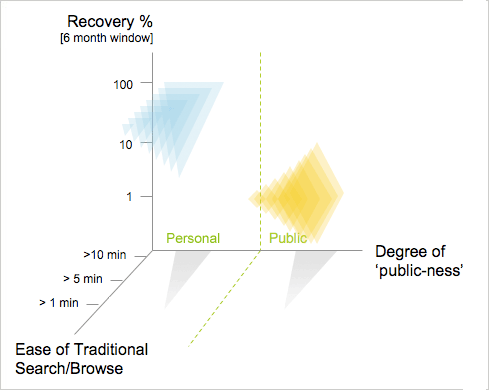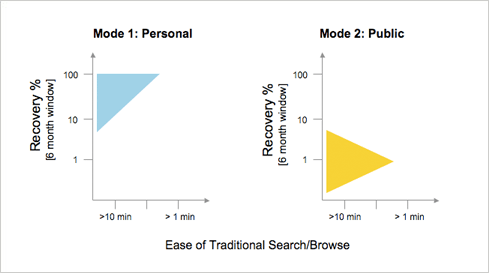Master diagram-maker and designer, Tom Chi recently put together (and graciously allowed me to share) an insightful illustration that communicates how the utility of tags is bi-modally distributed across personal and public recovery. Personal utility is the value of a tagging system for individuals looking to recover their private documents or assets. Public utility is the value created by an aggregated set of tags from multiple individuals. In this case, members of the group are recovering public documents or assets using tags from the whole group.

The effort required for tagging proves most useful for individuals when the efficiency of available searching and browsing systems is low (5-10+ minutes for recovery) and the frequency of recovery is high.
For public recovery, utility also grows when available searching & browsing tools are inefficient. However, the system remains useful when the amount of recovery is low –when people are only accessing records occasionally.

These relationships help explain why frequent personal recovery tends to be a stronger motivator for tagging than occasional public recovery. They also highlight why tagging has caught on in areas with traditionally lower search & browse efficiency like photos (flickr) and Web bookmarks (del.icio.us).
Currently, photos can’t be properly interpreted by machines without human assistance and most digital photos lack enough metadata to enable efficient recovery. In the case of bookmarks, most Web browsers weren’t designed with bookmark searching in mind as evidenced by the inefficiency of using a browser’s bookmarks menu to access a long list of items.
But perhaps most importantly, the fact that there are two modes explains why there is often so much debate about which situations are best suited for tagging. Often one group is familiar with one mode or both parties draw examples piecemeal from the different modes while looking for a single formulation that describes both. This proves quite difficult because the two modes are different enough to significantly affect the situations where they are useful, as well as the design considerations around their display and interaction.